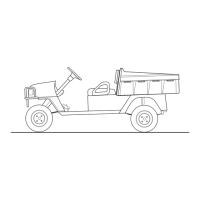GASOLINE UTILITY VEHICLES
Page 13
Owner’s Manual and Service Guide
Read all of manual to become thoroughly familiar with this vehicle. Pay particular attention to all Notes, Cautions and Warnings
In the best interest of both vehicle owner and servicing
dealer, carefully follow the procedures recommended in
this manual. Adequate preventative maintenance,
applied at regular intervals, is the best guarantee for
keeping the vehicle both dependable and economical.
In any product, components will fail to perform properly
as the result of normal use, age, wear or abuse.
A vehicle requiring repair indicates the vehicle is no
longer functioning as designed and should be considered
potentially hazardous. Use extreme care when working
on any vehicle. When diagnosing, removing or replacing
any components that are not operating properly, consider
the safety of yourself and those around you, should the
component move unexpectedly.
Some components are heavy, spring loaded, highly cor-
rosive, explosive, may produce amperage or reach high
temperatures. Gasoline, carbon monoxide, battery acid
and hydrogen gas could result in serious bodily injury to
the technician/mechanic and bystanders if not treated
with utmost caution. Be careful not to place hands, face,
feet or body in a location that could expose them to injury
should an unforeseen dangerous situation occur.
To prevent personal injury or
death, observe the following:
Before working on the vehi-
cle, remove all jewelry (rings, watches, necklaces,
etc.).
Be sure that no loose clothing or hair can contact
moving parts.
Use care not to touch hot objects.
Raise entire vehicle and support on jack stands
before attempting to run or adjust powertrain.
Hydrogen gas is formed when charging batteries.
Do not charge batteries without adequate ventila-
tion.
Do not permit open flame or anyone to smoke in
an area that is being used for charging batteries.
A concentration of 4% hydrogen gas or more is
explosive.
Engine exhaust gas (carbon monoxide) is deadly.
Carbon monoxide is an odorless, colorless gas
that is formed as a natural part of incomplete
combustion of hydrocarbon fuels. Carbon monox-
ide is a dangerous gas that can cause uncon-
sciousness and is potentially lethal.
The following are symptoms of carbon monoxide
inhalation:
• Dizziness
• Vomiting
• Intense headache
• Muscular twitching
• Weakness and sleepiness
• Throbbing in temples
If any of these symptoms are experienced, get
fresh air immediately. Never work around or oper-
ate a vehicle in an environment that does not ven-
tilate exhaust gases from the area.
NEUTRAL LOCK
To prevent the driven clutch from turning the rear wheels
during service operations, a neutral lock is located at
either the rear axle or at the direction selector.
Direction Selector Mounted Neutral Lock
To operate neutral lock located on direction selector, first
turn key switch to ‘OFF’ and lift seat. Then pull out and
rotate the neutral lock pin handle so that the pointed por-
tion of the handle hangs off the side of the direction
selector cam (Ref Fig. 20 on page 13). Move direction
selector lever towards the area between ‘F’ and ‘R’. Dur-
ing that motion, the pin will snap into the hole in the direc-
tion selector mounting bracket preventing any movement
of the lever. When in this position, the direction selector
remains locked in the neutral position. To activate the
direction selector, pull the neutral lock pin handle out and
rotate until the pointed portion of the handle fits into the
hole in the direction selector cam.
! !
Fig. 20 Neutral Lock (Direction Selector)
Neutral
Lock Pin
Handle
Hole in Direction
Selector Cam
(Unlock Position)
Hole in
Direction Selector
Mounting Bracket
Pointed
Portion of
Handle
(Shown in
Position
to Lock)

